Easy Way to Fill Pressure Water Can





A step-by-step tutorial on Canning Whole Tomatoes. This easy-to-follow process is perfect for beginners and covers preserving tomatoes in both water bath and pressure canning methods.
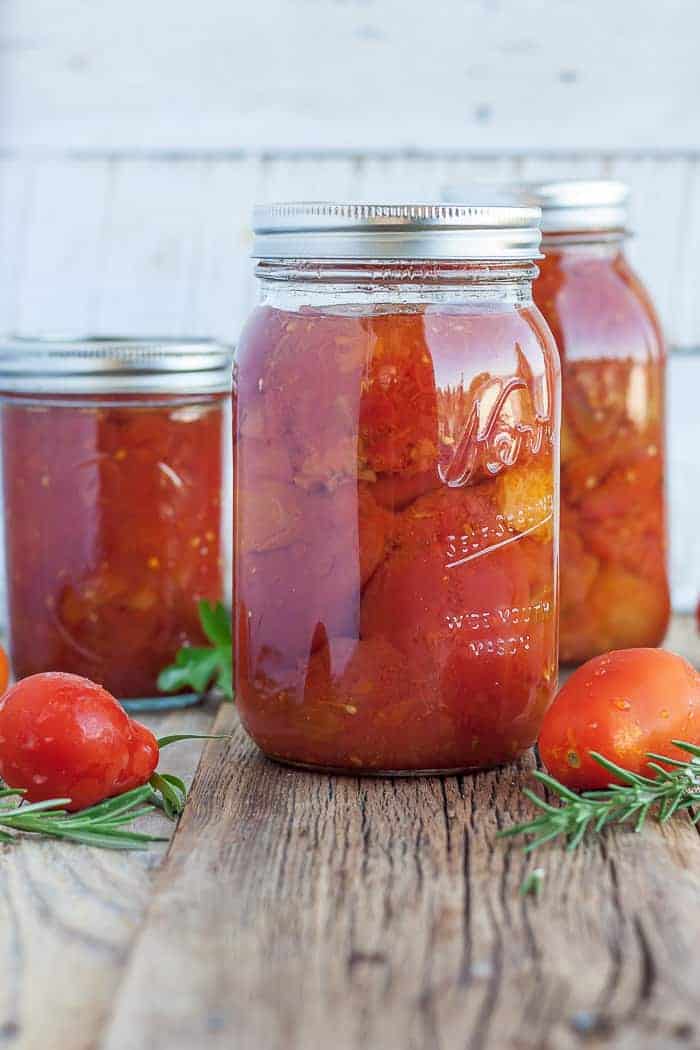
As an Amazon Associate, I earn from qualifying purchases.
Whole peeled tomatoes are one of the most versatile foods you can have in your pantry. They're great for making pasta sauce, to add to stews, and they are the shining star in my Dairy-Free Tomato Soup.
Canning tomatoes always feels like the end of summer canning season to me. While I'm busy putting up this crop, I'm also Canning Peaches, Dill Pickle Relish, Blackberry Syrup, Canning Stewed Tomatoes, and Canning Tomato Soup.
This recipe has both waterbath and pressure canning instructions so you can choose the method that works best for you. In my experience, it is a faster process in a pressure canner.
If you're busting out the pressure canner, try your hand at canning corn, canning green beans, canning beets, canning peas, canning potatoes, canning carrots or canning pumpkin. Both recipes require a pressure canner.
CANNING SUPPLIES & INGREDIENTS
Check out this in-depth post for a complete list of canning supplies.
You'll need:
- Tomatoes (no surprise there)
- Bottled lemon juice or citric acid
- Pressure Canner or water bath canner
- Large saucepan (I use my enameled dutch oven)
- Canning funnel
- Pint or quart canning jars (thrift stores are my favorite sources for these!)
- Jar lifter
- Ball Blue Book of Home Preserving
- Large mixing bowls
- Strainer
- Slotted spoon
- Ice
- Clean towels – 2 large ones for the counter, and 2 clean washcloths
HOW MANY TOMATOES DO YOU NEED FOR CANNING?
It is best to use low-moisture tomatoes like romas. This recipe will fill 7-quart jars. For 7 quarts you will need about 21 pounds of fresh tomatoes. It works out to about 3 pounds per quart. A quart jar will replace the 28-48 oz cans from the grocery store.
If you are canning pints, you'll need approximately 13 pounds for 9 pints. A pint jar will replace the 13-16 oz cans from the grocery store.
If purchasing in bulk, a bushel weighs 53 pounds and will yield approximately 15-21 quarts.
Pro tip: if you grow your own and don't have enough to can at once, you can freeze them on baking trays and then transfer to freezer bags (I love these reusable silicone bags). You do not need to thaw them before adding them to the boiling water to remove the skins.
WHY DO I NEED BOTTLED LEMON JUICE?
The lemon juice is needed to regulate the acidity of the fruit to keep the ph level consistent. Storebought lemon juice generally has the same level of acidity (5%) from bottle to bottle. You don't get that guarantee with freshly squeezed lemons.
RAW PACK FOR CANNING Tomatoes
Raw packing simply means placing the peeled fruit in the jars without precooking them, filling the jars with boiling water and processing them in the canner.
Raw packing is much faster than then a hot pack process, but there are some drawbacks. No matter how well you pack the jars, the density of the fruit will change during their time in the canner.
This often leads to something called "fruit float" in which the fruit will float to the top of the jar, leaving water (we call it tomato pee) on the bottom. You'll find this when you're canning pears and canning peaches as well. There is nothing wrong with fruit float as long as your jars are still sealed.
HOT PACK FOR CANNING tomatoes
Hot packing involves cooking them in boiling water for 5 minutes before packing them into jars for canning. The benefits of hot packing are that you typically can fit more per jar, and the near elimination of fruit float.
Canning Whole tomatoes
*water bath canning instructions are in the printable recipe card at the bottom of the post.
Rinse your tomatoes in a strainer. Using a paring knife, remove the stem/core. Place the tomato in a large bowl. I like to core about 75% of them at all once before the next step.
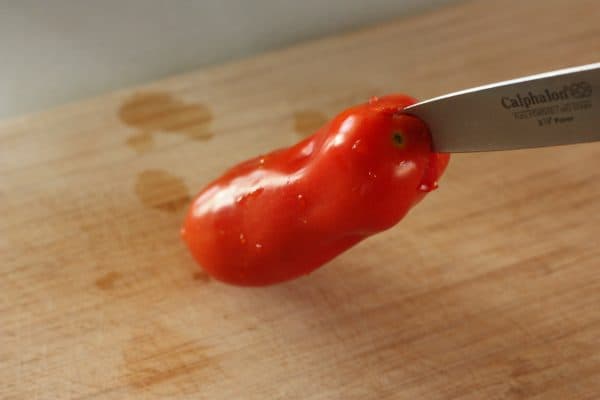
Don't ever hold a knife like this. But it is necessary when trying to take a photo and you're missing a third hand.
Prepare a large bowl with ice water.
Wash and clean your jars. It is no longer necessary to sterilize jars before canning (hurray!) but you shouldmake sure they are preheated enough to not crack when placed in hot water.
You can put them in a clean dishwasher and run them through a quick wash cycle, or place them in a large pan with some water in a low heat oven (my lowest temp is 170 degrees) until you need them. I've even just put hot tap water in them before and left them on the counter.
Wash your lids with hot soapy water and place them in a clean bowl for now.
(You can read more about this next step in-depth in this tutorial How to Blanch and Peel Tomatoes) Add the tomatoes to a pot of boiling water and parboil them until you see the skins start to come off (about 1-2 minutes).
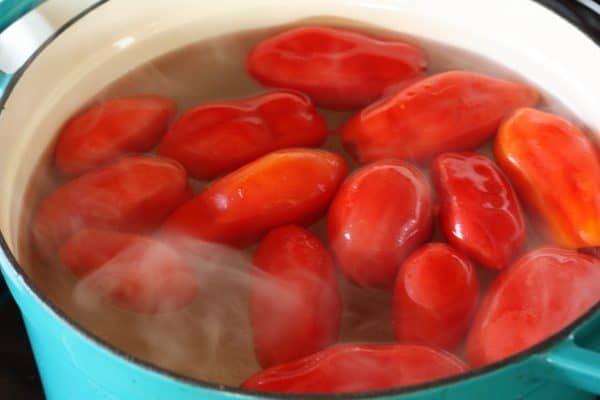
Use a slotted spoon and remove the tomatoes and place them in the ice water.
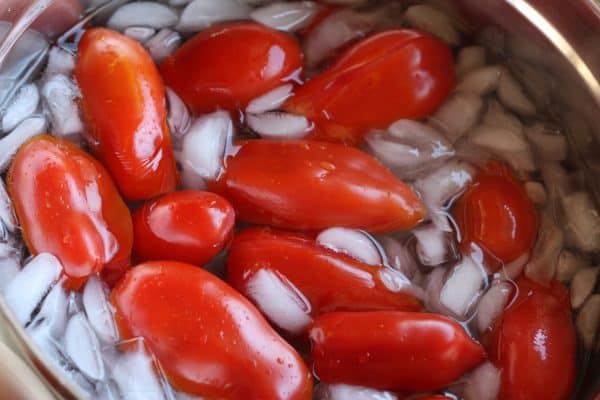
Working one at a time, remove any skin that hasn't already slipped off. Set the skins aside to make Homemade Tomato Powder.
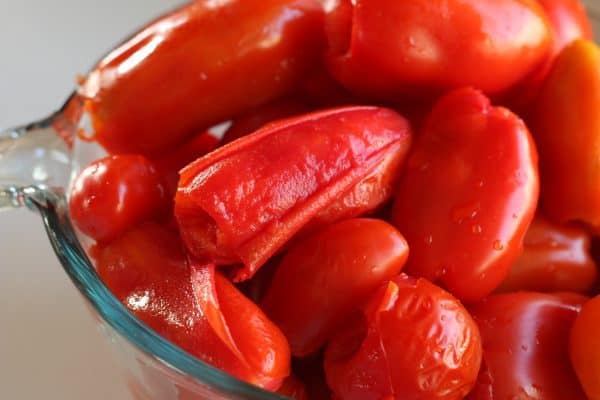
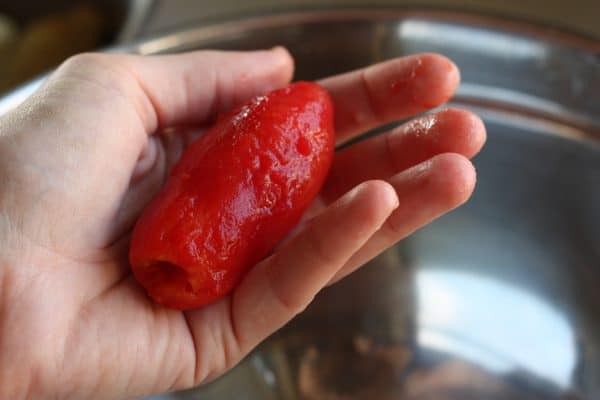
Holding the tomato awkwardly in your hand while you take a photo is key.
Once they are peeled, you can slice the tomatoes in half or leave them whole. The benefit of cutting them in half is that you can remove the seeds. The benefit of leaving them whole is it is easier and faster!
If you are hot packing, add the peeled tomatoes to a pot of boiling water and let them cook for 5 minutes.
Add 3 quarts of water to your pressure canner and put it on a burner set to high. Make sure there is a canning rack in the bottom of the canner.
Add lemon juice or citric acid to your canning jars (see recipe card below for exact measurements).
Using a canning funnel, ladle hot tomatoes in the jars. Ladle in clean boiling water, leaving 1/2 inch headspace. Headspace is the distance between the top of the food and the top of the jar.
Using a long utensil (I prefer a plastic chopstick), remove all the air bubbles from the jar.
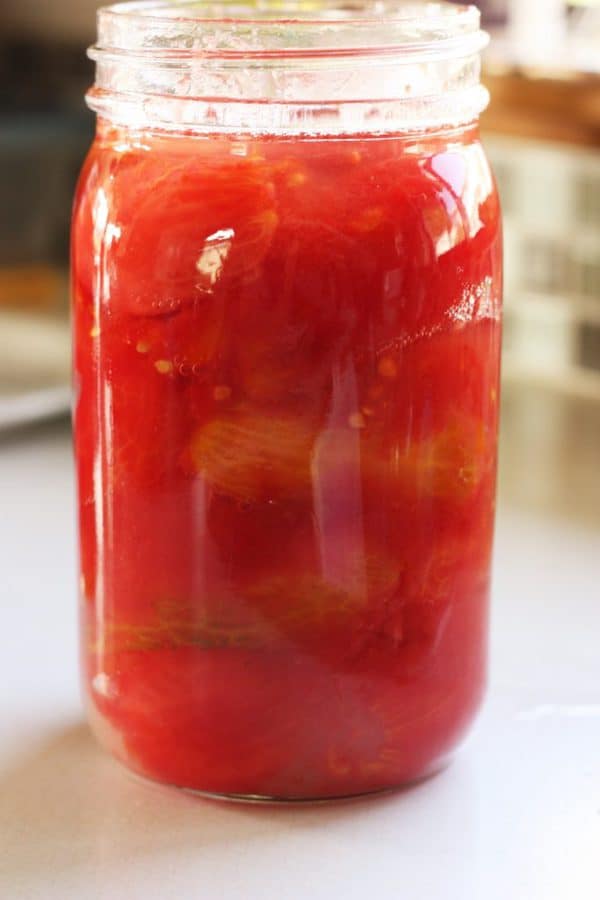
Clean the rim of the jar very well with a hot damp rag. Any juice or bits of tomato left on the rim may impact the seal of the lid in the canner.
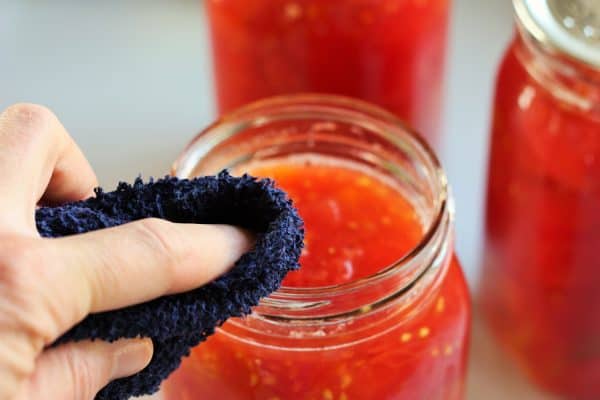
Place a clean lid on the jar. Add a ring, and tighten to fingertip tight.
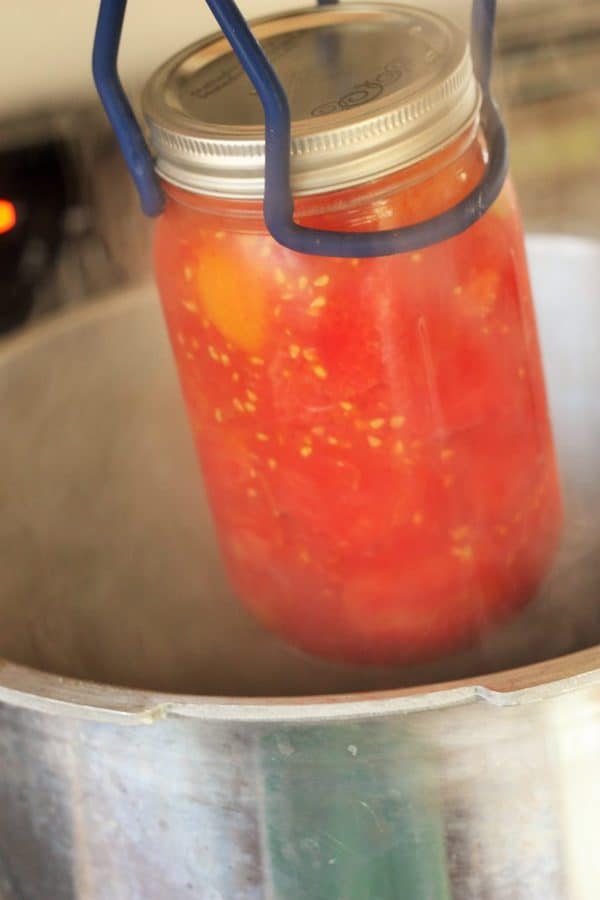
Making some "no no, it's too hot, don't put me in there" voices is optional when putting the jars in. Optional, but entertaining.
Using canning tongs, gently place the jars in the canner. Lock the lid. Soon, steam will start coming through the vent pipe (I call it the steam chimney). Allow the steam to pass through for about 10 minutes. Then put the pressure regulator (I call it the chimney cap) on top.
Pretty soon, the air vent will pop up. That is a sign that you're starting to build pressure inside the canner (yay!). Under normal conditions, whole tomatoes packed in water need to be pressure canned at 11 pounds of pressure for 10 minutes for both pints and quarts. See chart below for any changes to processing times.
When the dial gauge reaches 11 pounds of pressure, reduce the burner temp to medium, and start your timer. The pressure must stay at 11 or (a little bit) above for the duration of the cooking time. You'll likely need to adjust the temp on the burner a few times depending on your stove.
When the time is up, remove the canner from the burner and allow it to sit until you hear a distinctive "click" of the air vent dropping. Remove the pressure regulator and carefully remove the lid ( Pro tip : I always use oven mitts when I take the lid off because the steam is super hot).
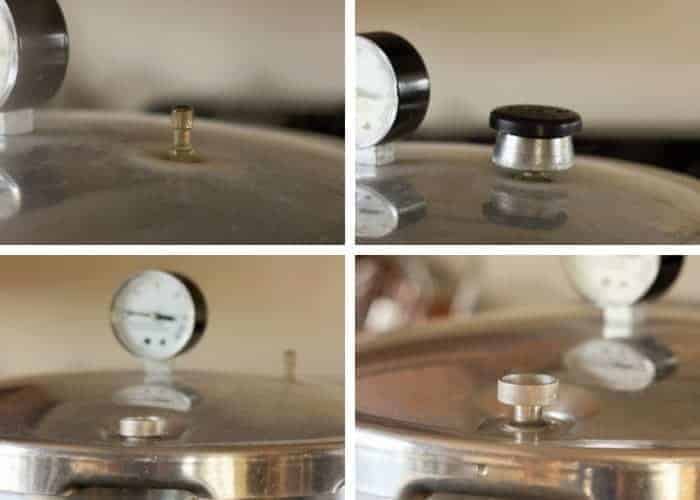
Let the jars sit for 5 minutes in the canner and then lift them out with canning tongs. Place on a towel where they can sit undisturbed for 12 hours.
After a few hours, to check for sealing, gently press down in the middle of the lid. If the lid has no give, it's sealed. If you can press the lid in and it pops a bit, your jars are not sealed. You can reprocess them or store them in the fridge or freezer (only freeze jars that are wide mouth).
Pro Tips/Recipe Notes:
- You can add salt to each jar prior to canning it. Use pickling salt and add 1/2 tsp per quart. Personally, I find unsalted whole peeled tomatoes easier to use in recipes because it allows me to control the overall sodium.
- Pressure canners can often leave white lines on lids and rings. It's totally normal and safe. To prevent this, add 1/3 cup of white vinegar to the canner before processing.
- If you don't have enough jars to fill the canner, consider Canning Water in a few jars to stock your emergency drinking water supplies.
- If you have leftovers you just don't want to process, you can learn how to freeze tomatoes the easy way.
More Great Preserving & Canning Recipes
- Check out all my canning recipes!
- How to Dehydrate Tomatoes
- How to Freeze Fresh Produce
- How to Can Peas
- Canning Beets
- Canning Corn
- How to Can Green Beans
- Canning Potatoes
- Canning Apple Pie Filling
- How to Can Pumpkin
- Low-Sugar Strawberry Jam
- How to Can Apple Butter
- Refrigerator Dilly Beans
- Canning Cranberry Sauce
Canning Whole Tomatoes {How to Can Tomatoes}
A step-by-step tutorial on how to can tomatoes.
- 21 lbs tomatoes
- 14 tbsp bottled lemon juice (2 tbsp per quart)
How to Pressure Can Whole Tomatoes
-
Rinse your tomatoes. It is best to use a low-moisture tomato like romas.
21 lbs tomatoes
-
Using a paring knife, remove the stem/core from the tomatoes. Place in a large bowl. I like to core about 75% of them at all once.
-
Wash and sanitize your jars. You'll want to keep them warm to avoid having them crack when placed in the canner. You can fill them with hot water, or place them on a tray in the oven at 170F.
-
Wash your lids with hot soapy water and place them in a clean bowl for now.
-
Fill a large saucepan with water and bring it to a boil.
-
Prepare a large bowl with ice water. Set aside.
-
Add the tomatoes to a pot of boiling water and parboil them until you see the skins start to come off the tomatoes (about 1-2 minutes).
-
Use a slotted spoon and remove the tomatoes and place in the ice water.
-
Working with the tomatoes one at a time, remove any skin that hasn't already slipped off.
-
Once they are peeled you can slice the tomatoes in half (to remove all the seeds) or leave them whole.
-
If you are hot packing your tomatoes add them to a pot of boiling water and let them cook for 5 minutes.
-
Add 3 quarts of water to your pressure canner and put it on a burner set to high. Make sure there is a canning rack in the bottom of the canner.
-
Add lemon juice or citric acid to your canning jars.
Quarts: 2 tbsp lemon juice OR 1/2 tsp citric acid. Salt (optional) 1 tsp
Pints: 1 tbsp lemon juice OR 1/4 tsp citric acid. Salt (optional) 1/2 tsp
14 tbsp bottled lemon juice
-
Using a canning funnel, ladle hot tomatoes in the jars. Cover tomatoes with clean boiling water.
-
Leave 1/2 inch headspace. Headspace is the distance between the top of the food and the top of the jar.
-
Using a long utensil (I prefer a plastic chopstick), remove all the air bubbles from the jar.
-
Clean the rim of the jar very well with a hot damp rag.
-
Place a clean new lid on the jar. Add a ring, and tighten to fingertip tight.
-
Using canning tongs, gently place the jars in the canner. Lock the lid. Soon, steam will start coming through the vent pipe.
-
Allow the steam to pass through for about 10 minutes. Then put the pressure regulator on top. (see photos in post above to see this in action)
-
Pretty soon, the air vent will pop up. That is a sign that you're starting to build pressure inside the canner. Whole tomatoes need to be pressure canned at 11 pounds of pressure for 10 minutes for both pints and quarts. (see time chart in post for adjusted times for elevation and water bath canning).
-
When the dial gauge reaches 11 pounds of pressure, reduce the burner temp to medium, and start your timer. The pressure must stay at 11 or (a little bit) above for the duration of the cooking time. You'll likely need to adjust the temp on the burner a few times depending on your stove.
-
When the time is up, remove the canner from the burner and allow it to sit until you hear a distinctive "click" of the air vent dropping. Remove the pressure regulator and carefully remove the lid ( Pro tip : I always use oven mitts when I take the lid off because the steam is crazy hot).
-
Let the jars sit for 5 minutes in the canner and then lift them out with canning tongs. Place on a towel where they can sit undisturbed for 12 hours.
-
After a few hours, to check for sealing, gently press down in the middle of the lid. If the lid has no give, it's sealed. If you can press the lid in and it pops a bit, your jars are not sealed.
Water Bath Canning Instructions
-
Follow steps 1-18 above in the Pressure Canning Instructions.
-
Prepare your water bath canner by filling it with water. You just need to have enough water to cover the jars by 2 inches once the water is boiling.
-
Set the canner fitted with the lid on the stove. Turn the burner to high. Once it reaches a boil, reduce it to simmer. You want to keep the water hot so that everything is ready when the tomatoes are.
-
Return the water in the canner to a rolling boil.
-
Using canning tongs, carefully lower the jars into the boiling water and place the lid on and set your timer.
-
Pints should process for 40 minutes and quarts for 45 minutes. Pro tip: the water must return to a full boil in the canner before you can start the timer.
-
Once the tomatoes have processed for the appropriate amount of time, remove the canner from the burner, carefully take off the lid, and allow it to sit for 5-10 minutes. Pro tip: I tend to just slide it into the middle of my stove, as it weighs a ton.
-
Carefully remove the jars using canning tongs, and place them on a thick towel in a place where they can be undisturbed for 12 hours. The lids should start to pop/ping within 20-30 minutes of being removed from the water.
Recipe cook times based instructions from the National Center for Home Food Preservation.
22 lbs tomatoes per 7 quarts, or 14 lbs tomatoes per 9 pints. About 3 lbs tomatoes per quart.
Store in a cool dark place for 9-12 months.
Nutrition Facts
Canning Whole Tomatoes {How to Can Tomatoes}
Amount Per Serving (1 g)
Calories 252 Calories from Fat 27
% Daily Value*
Fat 3g 5%
Saturated Fat 1g 6%
Sodium 68mg 3%
Potassium 3256mg 93%
Carbohydrates 55g 18%
Fiber 16g 67%
Sugar 37g 41%
Protein 12g 24%
Vitamin A 11335IU 227%
Vitamin C 198mg 240%
Calcium 138mg 14%
Iron 4mg 22%
* Percent Daily Values are based on a 2000 calorie diet.
Shop this Post:
(may include affiliate links)
Source: https://www.sustainablecooks.com/canning-whole-tomatoes/
0 Response to "Easy Way to Fill Pressure Water Can"
Post a Comment